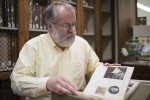Books with handwritten anecdotes from parents capturing their child’s earliest moments and locks of hair from their baby’s first haircut sit behind the gleaming glass panels in the Powell Library rotunda.
Some of the books are light pink with intricate bindings. Others feature pop-up art, newspaper clippings or black and white photographs.
Overhead, a picture of a stork carrying a baby in a basket is displayed on a screen which reads, “Grow(ing) Up! The UCLA Library Baby Record Books Collection.”
UCLA Library Special Collections’ Baby Record Books Collection is celebrating its 10th anniversary in the library this March. The display, which runs now through April 2014, includes selections from the collection that includes about 1,400 baby memory book.
The books were filled by parents as far back as the 19th century to record developmental milestones from their children’s early years.
At UCLA, the collection serves as a resource for anyone who wants to learn more about pediatrics and child healthcare. But it also serves as a way to showcase the similarities between children raised in different cultural and economic backgrounds.
“It’s something (students) can relate to,” said Catherine Brown, the reference collections, exhibits and events coordinator at the UCLA College Library. “(Students can) see how they’ve evolved and, in some ways, how they stayed the same … (It) tells a story of (a) population.”
The collection began in 2004 when Barbara Rootenberg, a Sherman Oaks antiquarian bookseller, donated the first book to the UCLA Louise M. Darling Biomedical Library.
Rootenberg donated a copy of a memory book that was filled in 1885 with handwritten descriptions of the early life of a London physician’s child.
At the time, she asked Russell Johnson, the curator for History and Special Collections for the Sciences at the UCLA Biomedical Library, if the look into the past could provide any medical information about child development.
“We started looking around and we discovered that no library was collecting these books,” Johnson said.
Rootenberg, an alumna of the UCLA Department of Information Studies and co-owner of B & L Rootenberg Rare Books & Manuscripts, has added on to the collection since it began. She said she thinks having this collection is important because it brings people from all over the world to UCLA for research.
Some books also have information about how to raise babies, serving a dual purpose for the parents who owned the books.
“Baby books reflect a very important piece of history,” said Howard Rootenberg, the president of B & L Rootenberg Rare Books & Manuscripts and son of Barbara Rootenberg. “There are different standards in different parts of the country and different means of dealing with (the) health of a child.”
The library gathers the collection’s books from eBay, swap meets, booksellers and donations and buys them using library endowment funds. Howard Johnson said he thinks the Baby Record Books Collection at UCLA is the first of its kind.
Johnson’s book is one of several books in the library that holds no information inside. It just has empty pages.
The youngest of three children, Johnson said he thought his parents didn’t make a baby memory book for him because oftentimes parents stop filling the books after their first child.
For him, the collection is a home for baby books to be taken care of by someone who takes interest in the information they offer.
“I thought that I didn’t have (a baby book),” Johnson said, laughing. “I cleaned out my father’s house and I found my baby book in the attic and it had my name on it and that’s it. Nothing else.”
Johnson donated his family’s memory books to the collection after he found them in his father’s attic. Though his own book is empty, he said researchers have used it to analyze childcare advertisements on the back, which include fliers for diaper services, pharmaceutical amenities and local infant clothing boutiques.
The oldest book dates back to the 1870s, and the Special Collections library takes precautionary measures in order to preserve the books, Johnson said.
“Sometimes the cover of a book is really beautiful,” said Johnson, holding up a book with a baby-pink rayon cloth binding. “That was a common type binding in the 1940s, ’50s and ’60s, so we put (polyester plastic) on it just to protect it.”
Johnson said he welcomes any baby book to the collection, including those of UCLA students.
“We have every single different one that we could find through World War II and now we’re filling in the gaps for the last 70 years, so there’s all sorts (of books) out there that we don’t have,” he said.
In addition to the collection display, the UCLA Library Special Collections in the Charles E. Young Research Library will host a series of talks called Curator Conversations and feature the Baby Record Books Collection on April 3. Further details will be posted on the Special Collections library website.
Johnson said he hopes to offer the Baby Book Collection and the other collections from the UCLA Library Special Collections to classes on campus and integrate them into the school’s academic curriculum.
